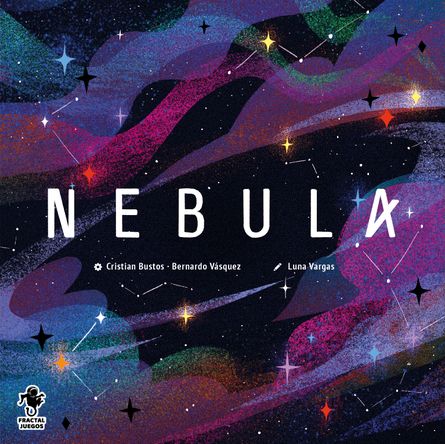SMOOSH JUICE
Game Review: Nebula, or The Fault in Our Star Layouts | BoardGameGeek News

When talking about games with others, I’m often reminded that we all have different takes on what we’re doing at the table, with one of the strongest distinctions being that some of us are creating stories, while others are moving plastic, cardboard, and wood into meaningful patterns. The rulebook of Nebula — a 2-4 player game from Cristian Bustos, Bernardo Vásquez, and Fractal Juegos — leans heavily into the former category:
Stars are born in nebulae. These come in various stages, from red giants to white dwarfs, and the laws of the universe ensure that they arrange themselves in perfect harmony. There are also stars without radiance that remind us that death is part of stellar life.
Bring your galaxy to life and find harmony within your constellations. Stories invented as you contemplate them will live on in time…
In Nebula, players take turns drafting colored bits from a shared area and placing them in a personal display to form meaningful patterns that will ideally net them more points than any other player.
In the abstract, this description sounds like any number of “take and make” games along the lines of Azul, Calico, and Cascadia. We share access to raw materials, but we’re each building our own thing and can (to varying degrees) ignore what others are doing when carrying out our turn.
In more detail, on a turn either you move the three moons a total of five spaces around the perimeters of the star clusters on the shared game board, then collect the stars next to the moons or you discard a star in your reserve to draw five stars from a bag and keep two, discarding the rest. You then place 2-3 stars on your personal game board, starting from the center and spreading outward over direct, indirect, and orbital links. Crucially, you cannot place stars of the same color on a turn, and no stars of the same color can be adjacent along any type of link.
In short, Nebula is a pattern-building game, and the patterns you build will depend upon the four public and one private objective available to you. (I mean, you can do what you want, but should you wish to score points, pay attention to those objectives.) The first player to complete a public objective scores more points than anyone else who does so later, and the game ends when a certain number of player markers have been placed on completed objectives.
Objectives will be along the lines of completing a particular constellation — that is, one of the four groups of six stars — with stars of exactly three colors, completing two adjacent constellations, placing two stars of specific color in three constellations, filling an orbit with X stars of differing colors, filling certain adjacent orbits, and so on.
If you’ve played games, you can imagine what these objectives are like, and you also know that you want to complete these objectives as efficiently as possible, with each star ideally helping to satisfy an objective or two, while also completing a constellation since those are worth 6 points each on their own. (Looking at the timeline of the universe, efficiency is not one of its hallmarks, but gamers probably wouldn’t pick up a design with a playtime in the billions of years.)
Nebula falls between Azul and Calico in terms of how you can affect the choices of other players. In Calico, the market is refilled after each player’s turn, so you can’t deny someone a lucky flip of the tiles and you’re unlikely to hate draft unless you can also use the tile in question, so it’s more like an incidental facepalm than outright hate. In Azul, the market empties out completely each round, so you can sometimes force a player to take a color they can’t place or more than they need on order to cost them points.
In Nebula, a star cluster refills only when it contains a single star (or two stars in a two-player game), but you’re free to place a moon on an empty space, thereby leaving two stars in a cluster so that some other chump has to refill it and give better options to the next player.
What’s more, while an objective may force a color choice, e.g., place six blue stars on your board, you can hate draft somewhat effectively since some star locations will be “throwaways” and can be, say, any color other than blue or yellow. A player can “resort to chaos” — that is, discard a star to draw five from the bag — to find a color they need, but with seven colors in the game, we’ve have more failure than success with those desperate draws.
Aside from the introductory efficiency game, Nebula includes a “full game” that introduces an additional game board. In the introductory game, black stars function only something to collect for a few points — 2 points each for the first three, 3 points each for the next three, etc. —whereas in the full game, you both score those points and create an additional way to score points by boosting the value of a particular constellation, assigning a point value to a star color, or putting a new objective into play, ideally one that overlaps with everything else you’re doing.
The full game of Nebula is still an efficiency game; you’re just given many more elements to try to sandwich together in order to maximize the value of each move. For full details of how to play and a detailed explanation of how the full game differs from the introductory one, watch this video:

/pic7378125.jpg)
/pic8801686.jpg)
/pic8801773.jpg)
/pic8801783.jpg)